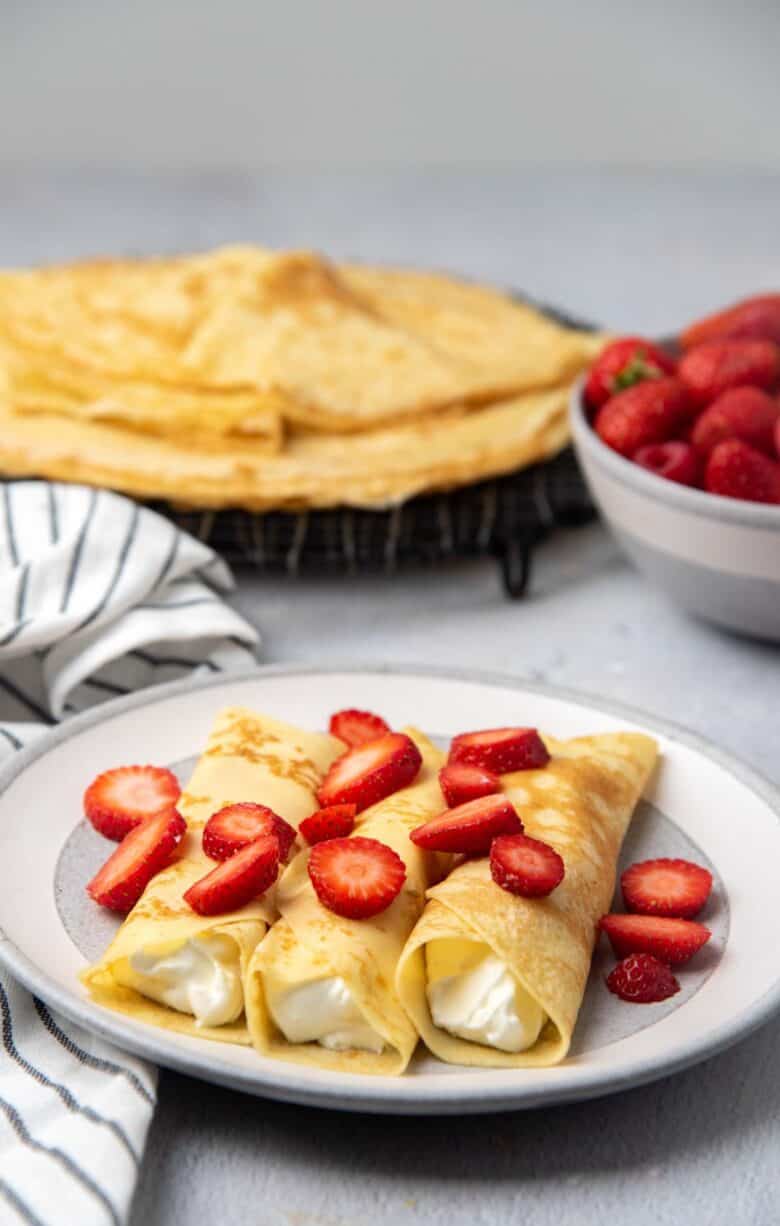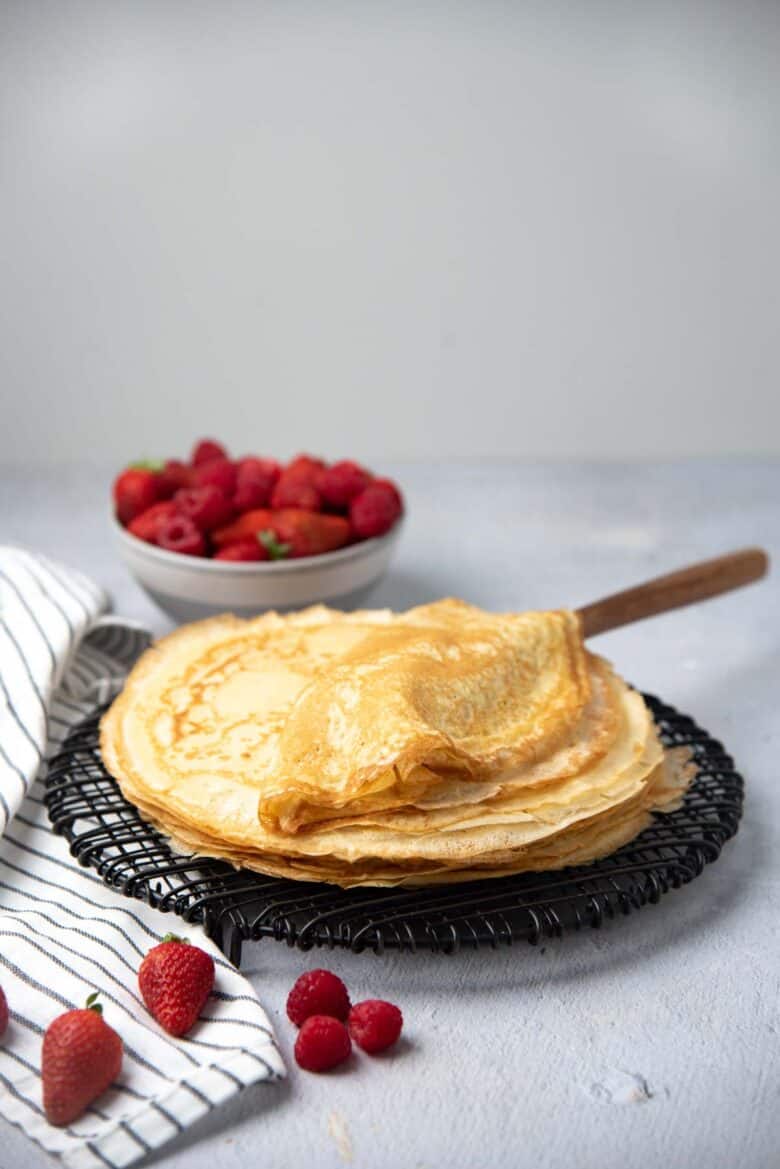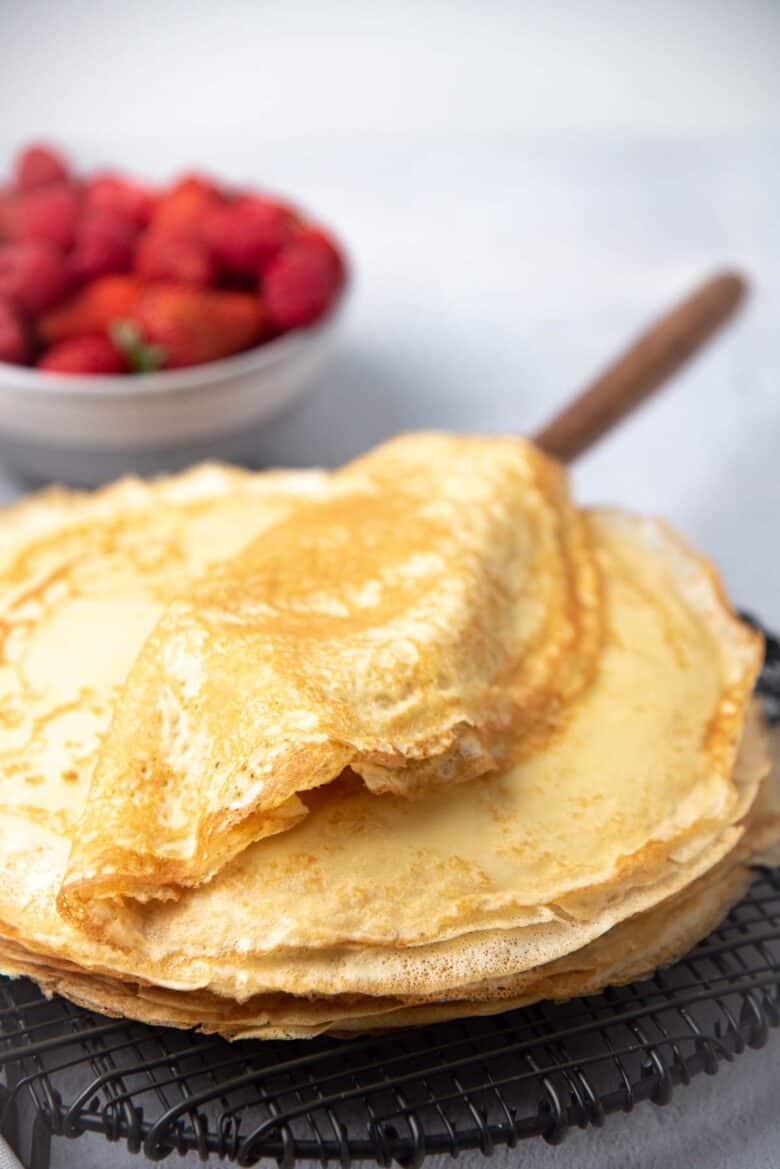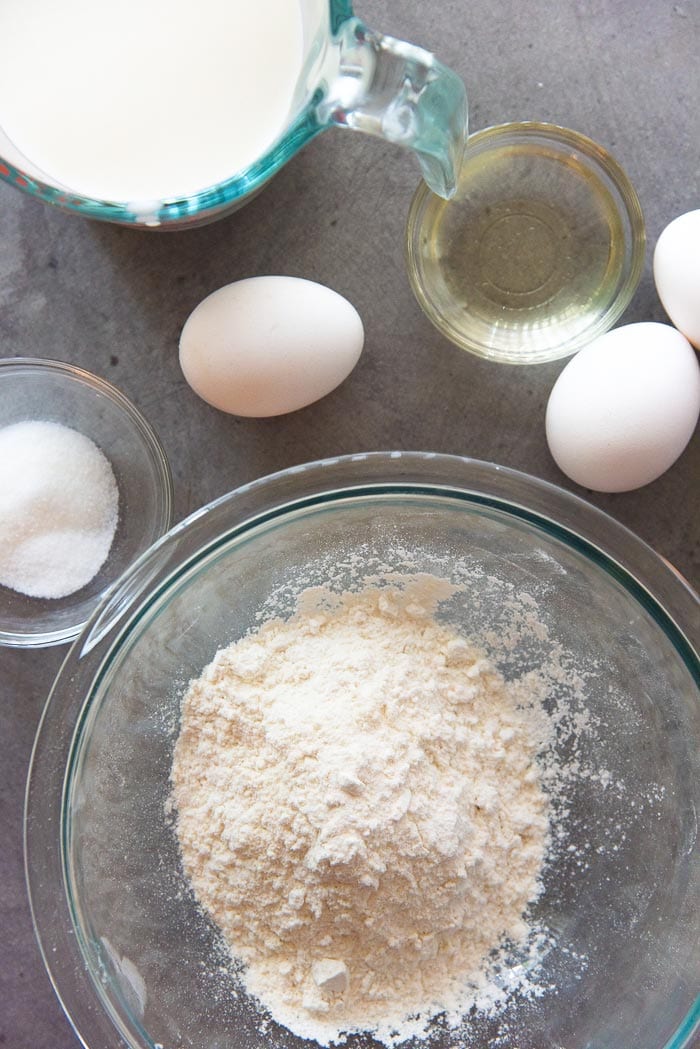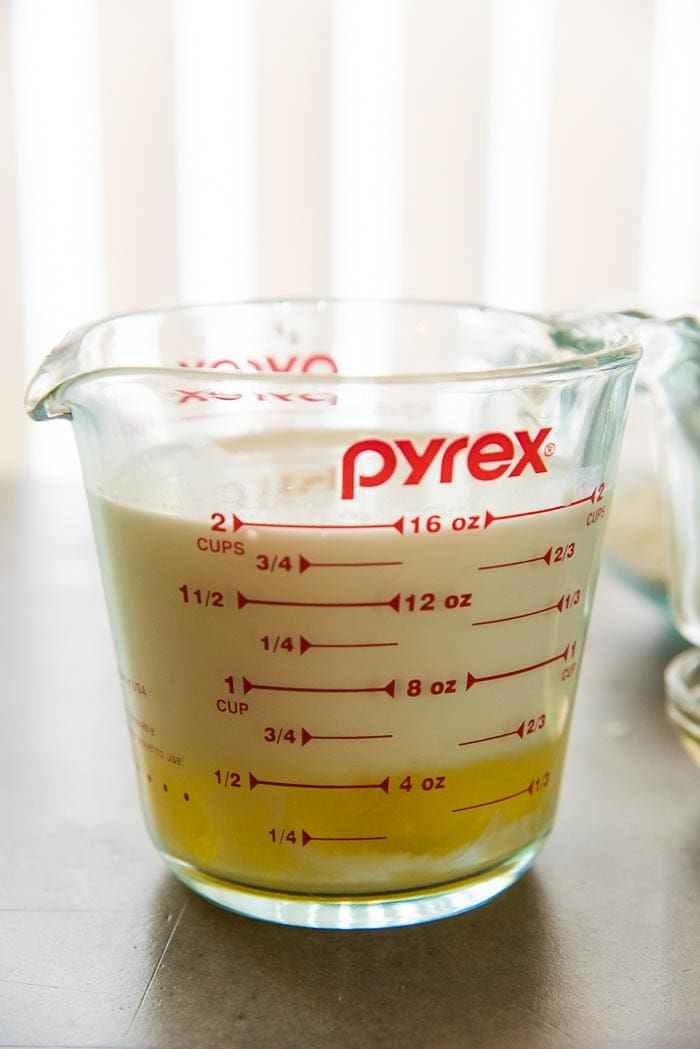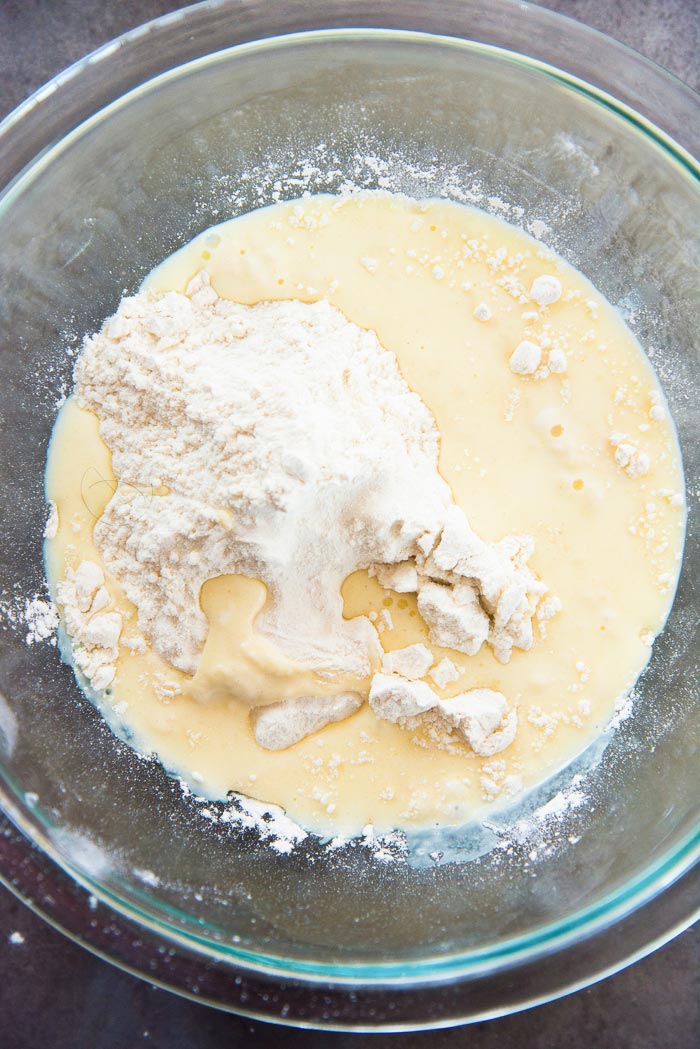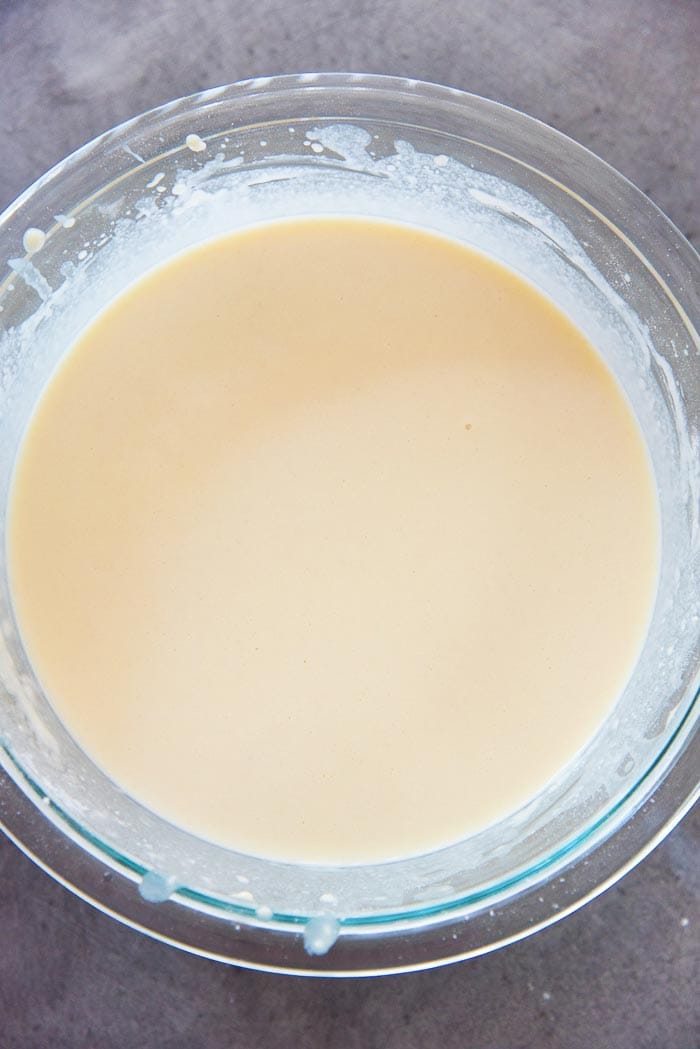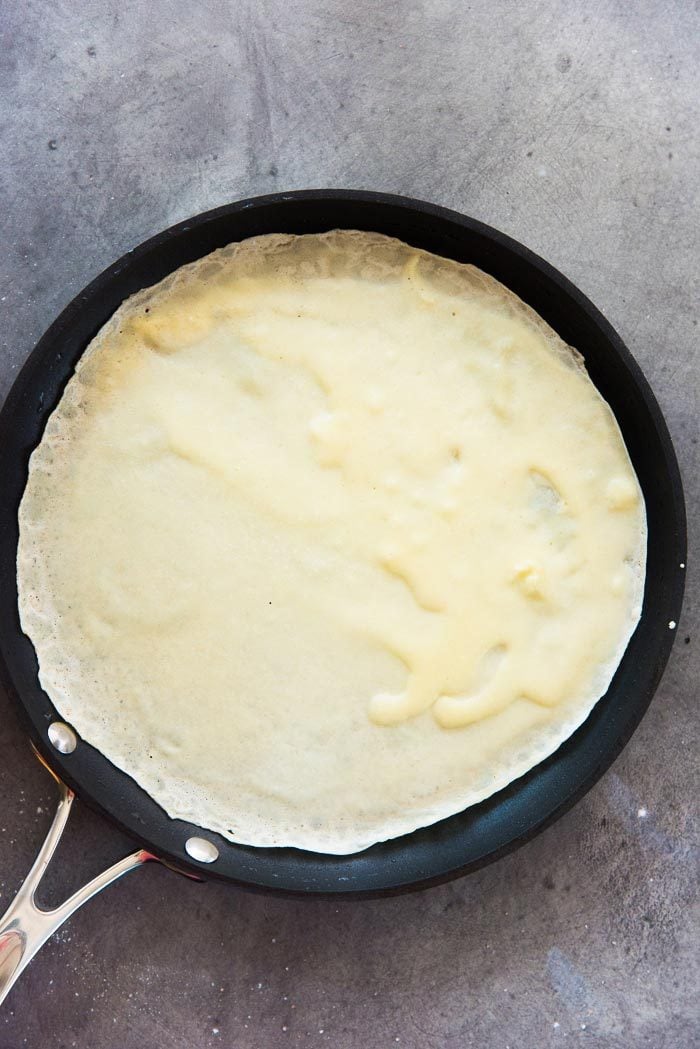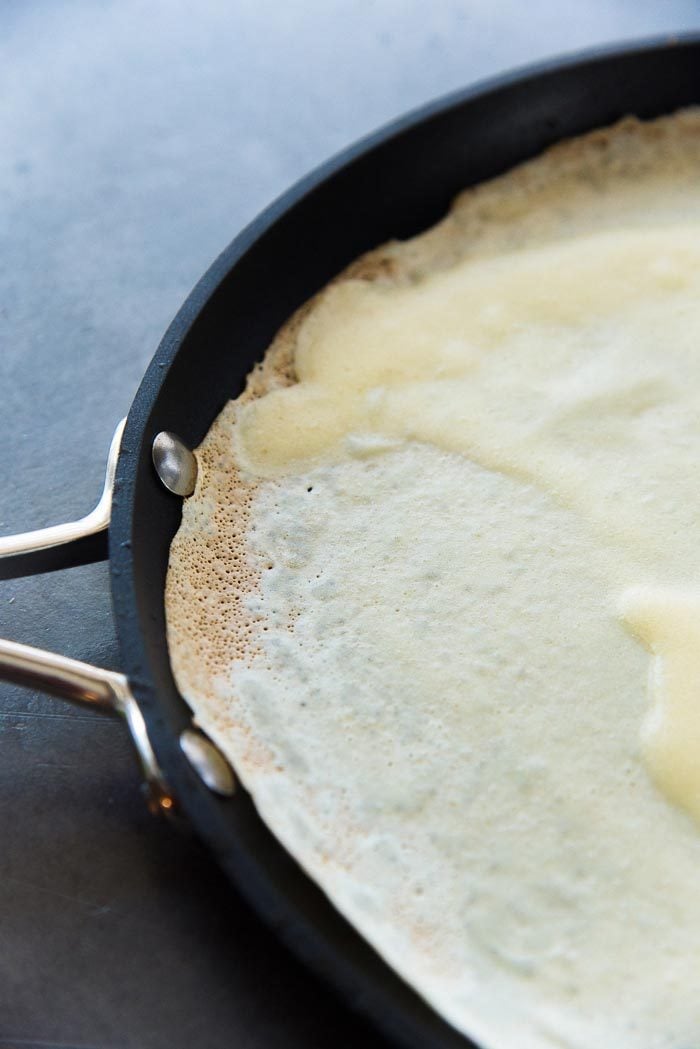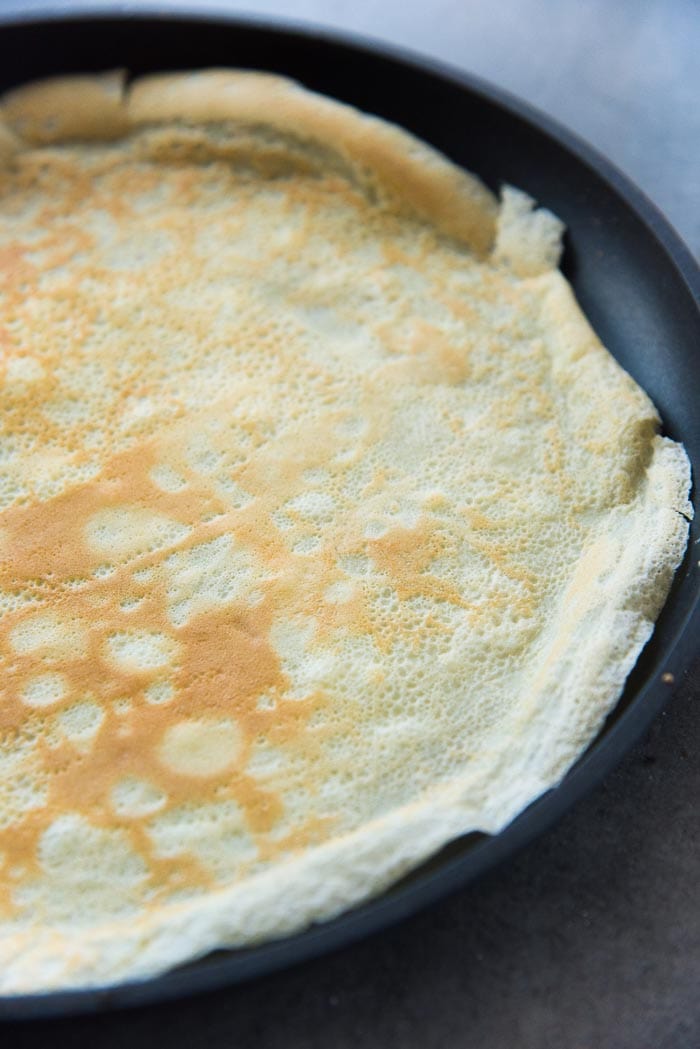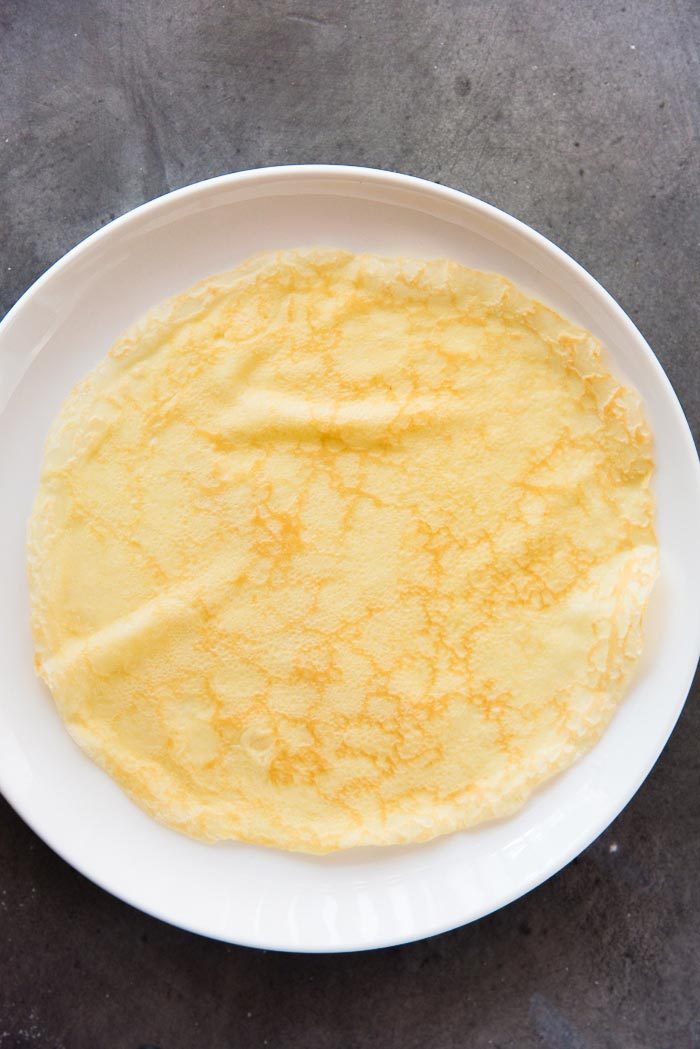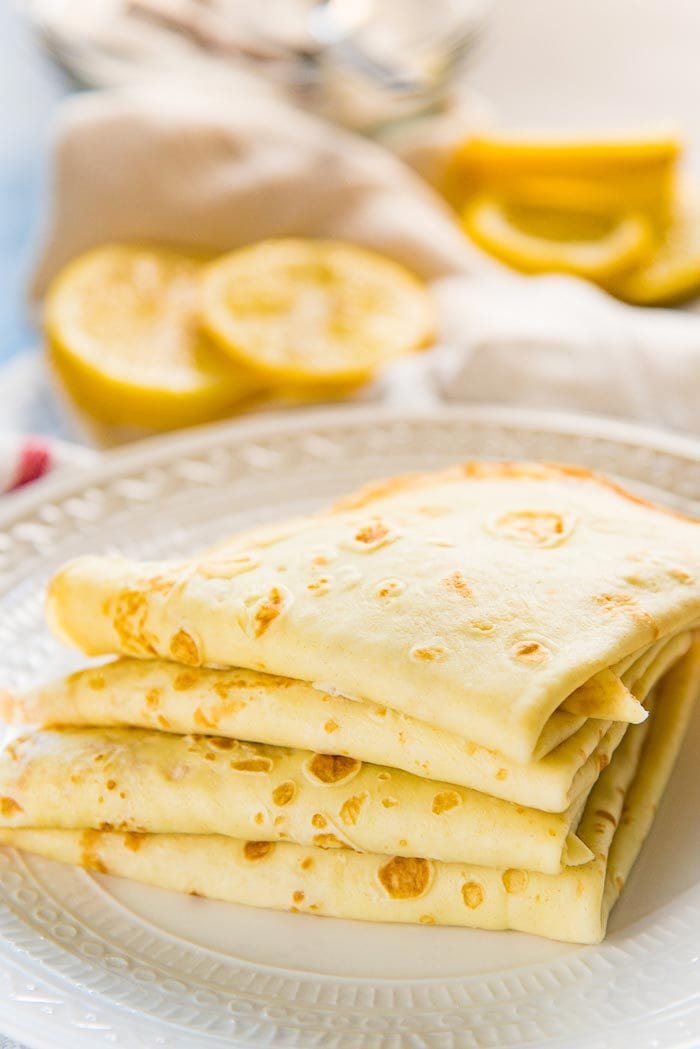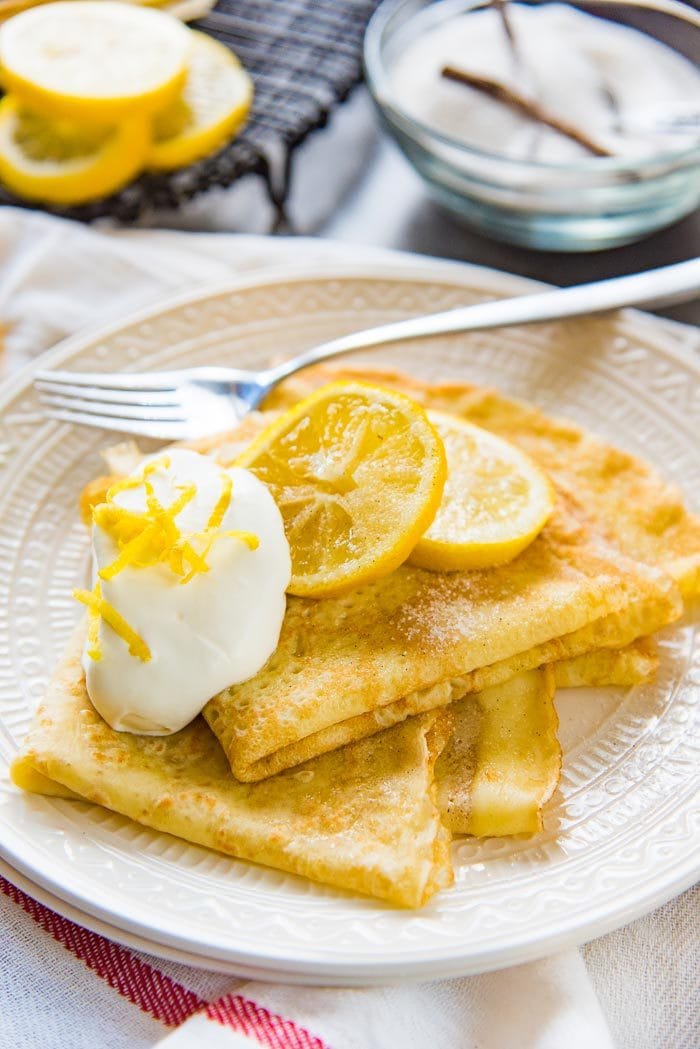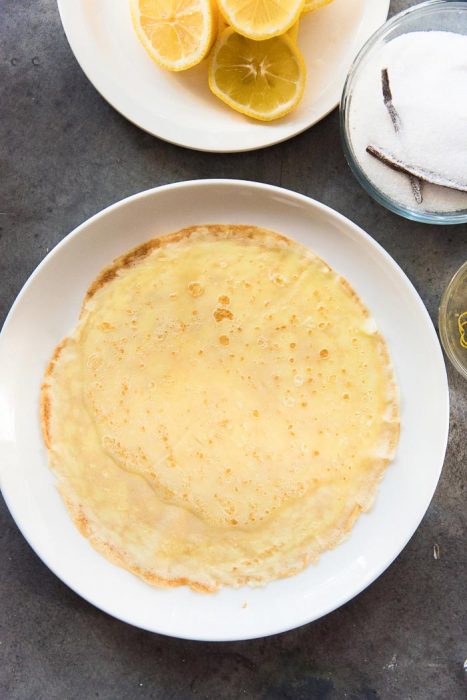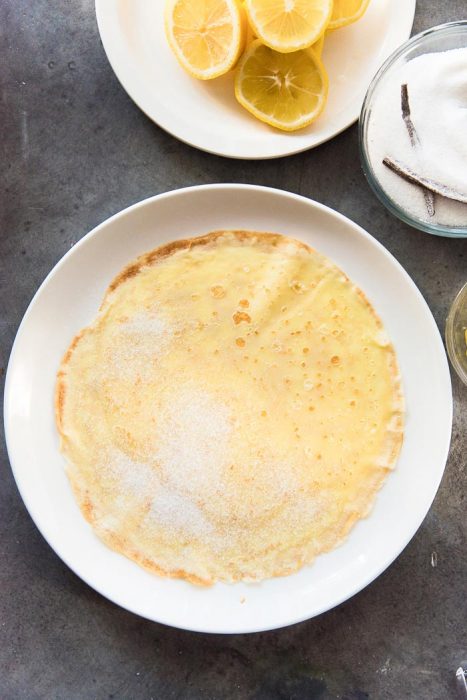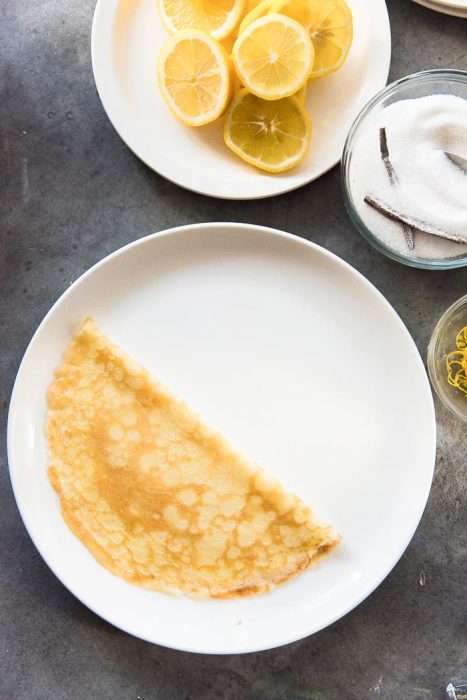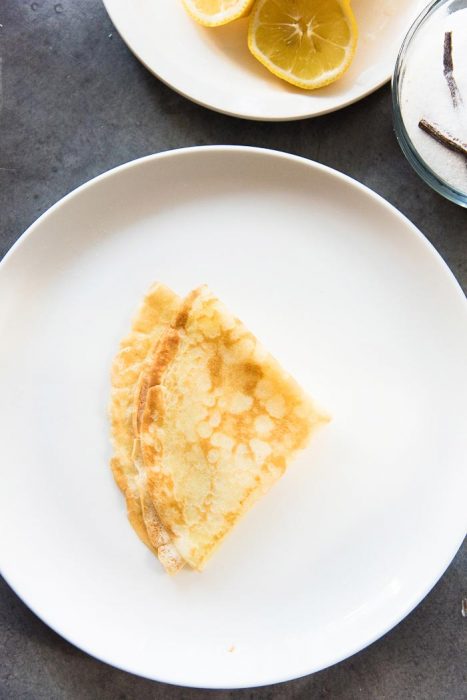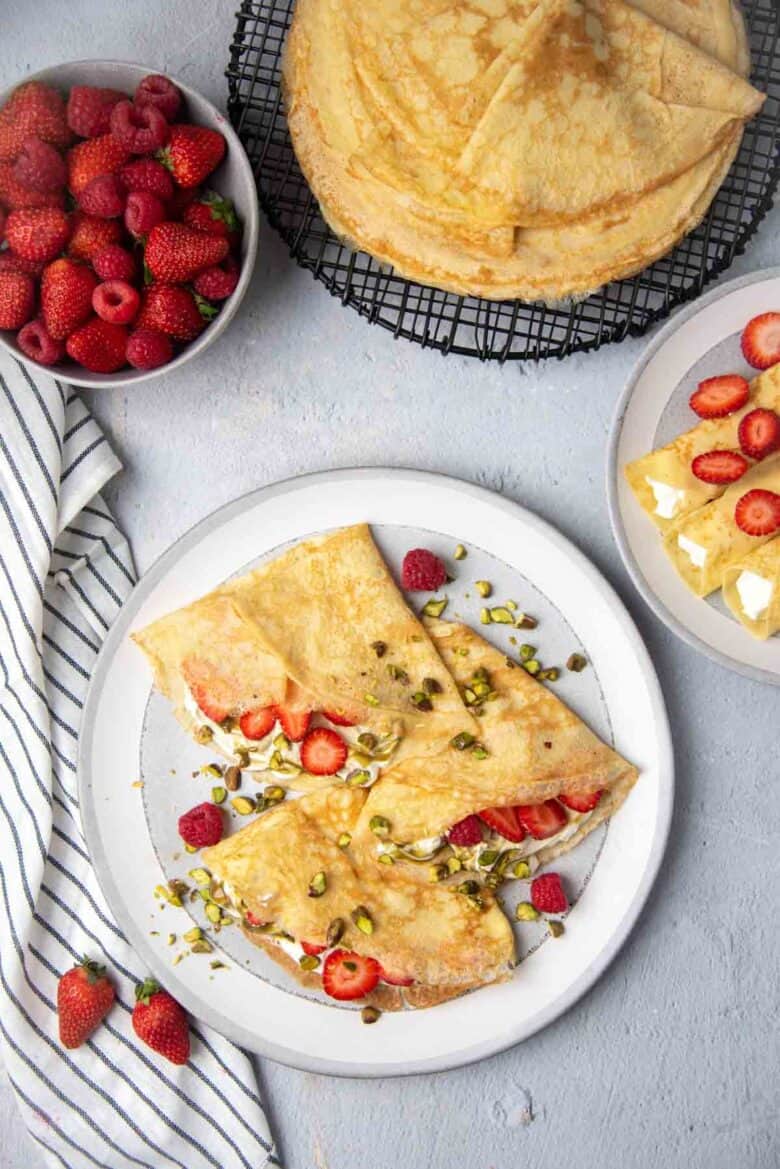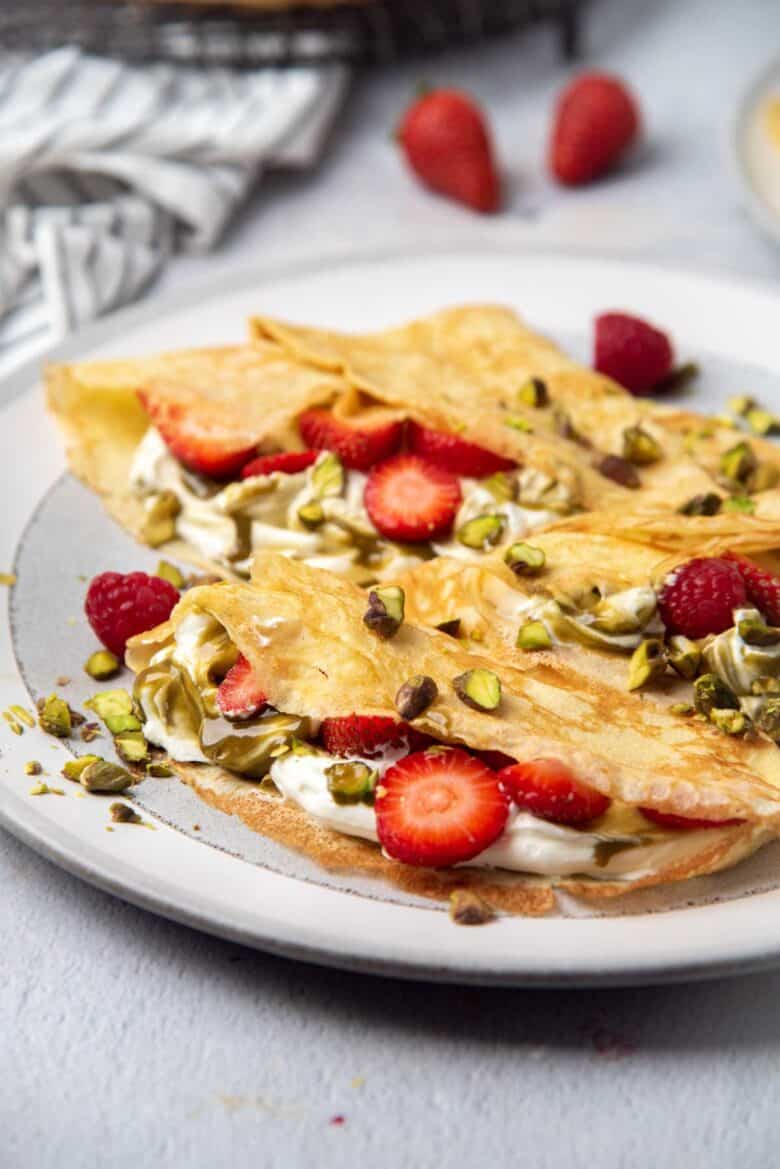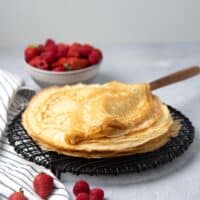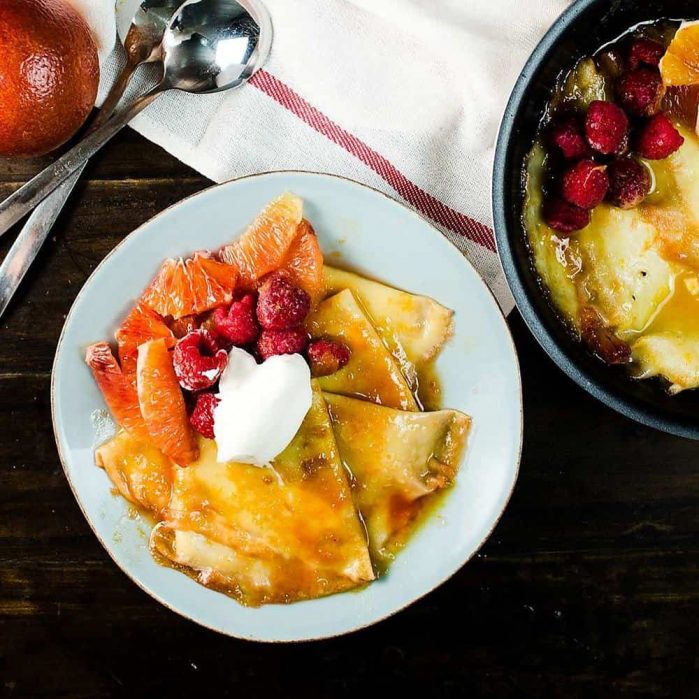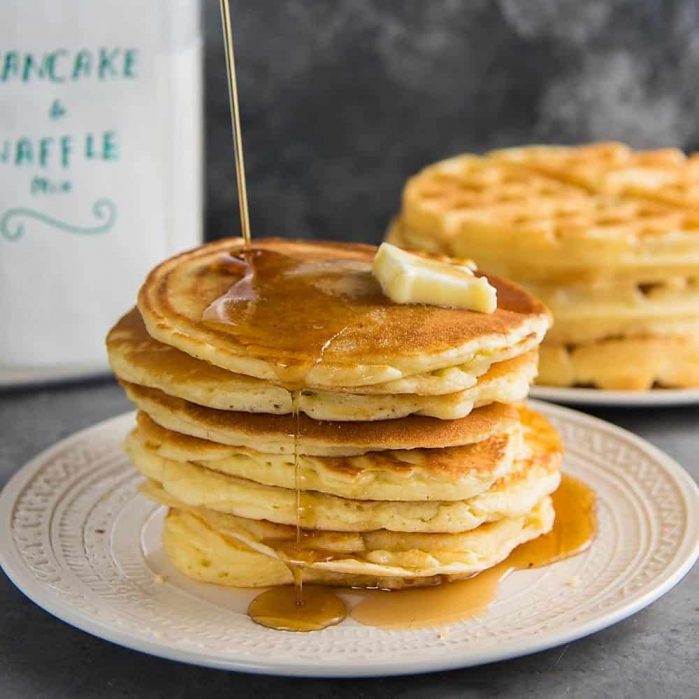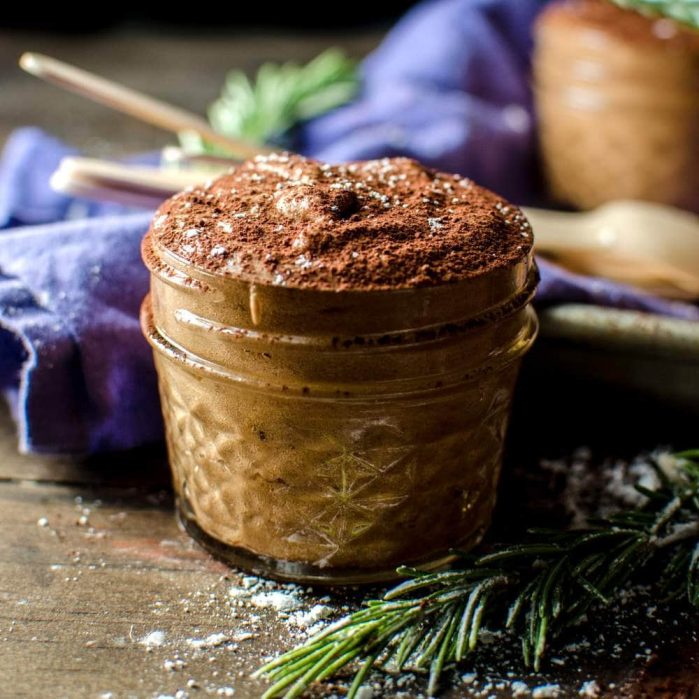This easy crepes recipe is very versatile as a sweet or savory option for breakfast, brunch, lunch, dinner, or even dessert!
What are crêpes?
The origin of crepes is a fascinating one, and you can read all about it here. In essence, crepes are the European cousin of American pancakes. They are delicate, thin pancakes that are popular in France, and they are irresistibly soft, delicious, and buttery. Most people make sweet crepes, but savory crepes are most definitely a thing too. Crepes can be filled with anything from fruity jam or Nutella to ham and cheese, bacon, cooked meat, seafood etc.! Traditionally, crepes are made with buckwheat flour and filled with savory fillings (called Galette Bretonne). But you can make savory crepes with flour-based crepes too. Crepes are popular in many different types of restaurants throughout France, Europe and elsewhere. And they are perfect for breakfast, brunch, lunch, dinner, dessert, i.e. basically whenever you crave some. In the UK however, pancakes are similar to crepes, except they are a little thicker than regular crepes. But the batter for French crepes and UK pancakes is similar and has no leavening agent. Here I’ll show you how EASY it is to make classic French crepes, and share some pro tips on how to make crepes. You’ll learn how to make sweet crepes and savory crepes, how to fill them and serve them, PLUS I will share ingredient substitutions to make gluten free crepes and vegan crepes as well. Eggs – I use large eggs. Each egg is about 52 – 55 g, without the shell. Melted butter or oil – Butter is the best option for flavor, but you can easily substitute with oil as well. I like to add a little fat to the batter to make the crepes a little softer and a touch richer in flavor. Salt – These French crepes will taste very bland without salt. So, make sure to add salt to your crepes batter. Sugar – Just a little bit of sugar helps balance the flavor of the crepes. But if you’re making sweet crepes, feel free to add more sugar to make the crepes sweeter. All purpose flour – This batter only needs a little flour. Too much flour will thicken the crepes batter and you won’t be able to cook nice, thin crepes. You can easily substitute the AP flour with wheat flour, buckwheat flour (traditional flour for savory galettes), or other GF flours. However, I find that this ratio gives me crepes that are a bit too eggy for my taste, so I add more milk and less eggs to my crepe batter. There are two ways to make crepe batter – with a whisk (in a bowl), or with a blender. With the blender, you can add all the ingredients and blend the crepe batter until you get a smooth batter. But with a whisk, there is a particular method in terms of how to mix the crepes ingredients to prevent lumps.
Using a bowl and whisk
Whisk the mix with the salt and sugar. Add all the wet ingredients into a jug and stir to combine. Add about half of the milk mixture into the flour and whisk to create a smooth, thick paste. Only mix until the flour has no lumps. Add the rest of the liquids and mix in. This will ensure that the flour will not form lumps for the crepe batter.
Using a blender or stick blender
You can use a regular blender or stick blender. However, I prefer to use a stick blender. Place all the crepes ingredients in the blender, making sure to add the dry ingredients first to the bottom. Then blend for about 1 – 2 minutes until you have a smooth crepe batter. For perfect results, I recommend leaving the crepe batter to rest for a little while to allow for the gluten to rest. You can even make the batter the night before and let it chill in the fridge overnight as well. The crepes are then cooked on a skillet over medium heat, allowing the crepes to be cooked quickly. This quick cooking time allows your homemade crepes to be soft and buttery, without drying out. You could use a French skillet pan to make the crepes as well, just make sure to butter the pan well so that the crepes don’t stick. If you’re new to making crepes, a regular non-stick pan is the best option.
How to make crepes in different-sized pans
Here, I use a 10 inch pan to make 10 inch crepes. But you can also use an 8 inch or 12 inch pan, depending on what you have at hand. As a rule of thumb, here are the measurements I use to make classic French crepes in different-sized pans.
8 inch pan – about 3 tbsp of batter (about 45 – 50 mL) 10 inch pan – about 1/4 cup of batter (about 60 mL) 12 inch pan – about 1/3 cup of batter (about 75 – 80 mL)
This is enough to create a thin layer of crepe batter on the bottom of each of these pans. Add the measured batter into the center of the pan. Swirl the pan as you add the batter. Work quickly to spread the crepe batter evenly around the pan all way to the edges, so that you have a smooth edge. Continue to swirl the pan (and occasionally shake it gently), to move the batter around and fill the middle of the pan as evenly as possible. Once the bottom of the pan is evenly coated with the batter, place it back on the heat and cook.
For extra soft crepes
Expert tips for the best crepes recipe
I personally like to make the crepe batter the night before, and keep it covered in the fridge for the following morning. However, you can make this crepes recipe more in advance as well. Plus, if you make extra crepes, you can store leftovers for a later date too. Here’s how.
Refrigeration and reheating
To store these crepes, I like to layer each crepe between parchment paper, then wrap (or cover) the whole stack with plastic wrap, and store in an air-tight container. If crepes are exposed to air, they will dry out. So, it’s important to keep them covered with plastic wrap to prevent this. Keep these crepes in the fridge for up to 3 days, and you can preheat the crepes in batches in the microwave (parchment paper is microwave-safe). Make sure to set the microwave cook time to between 15 – 20 seconds at a time to prevent the crepes from over-heating and getting soggy.
Freezing and reheating
If you want to keep the crepes for longer than 3 days, then you can freeze them for later. When the crepes have cooled to room temperature, wrap them the same way as mentioned above, then place them in an air-tight container that is also freezer-friendly. This way, you can store the crepes for up to 2 months in the freezer. Let them defrost at room temperature or in the fridge, and warm them in the microwave as needed. When you’re ready to serve/eat the crepes, simply cover the crepes with another plate on top and microwave for about 30 seconds. The top plate allows the crepes to heat through steam, so that they don’t dry out. Remove the top plate as soon as you’re done microwaving so that the crepes don’t become soggy.
For sweet crepes
Lemon and sugar (a classic!) Whipped cream and berries (strawberry crepes are always a hit) Nutella crepes Banana crepes Cinnamon and sugar Honey Roasted nuts Fruity jams and spreads like this strawberry jam, plum jam, grape jam, fig jam etc. Chocolate sauce or ganache (you could even make chocolate crepes as a variation of this easy crepes recipe!) Sweetened Greek yogurt Whipped cream cheese Banana and caramel/butterscotch (check out this salted caramel chocolate crepe cake!) Fresh fruit Sweet coconut filling like in these Sri Lankan sweet coconut stuffed crepes (pani pol) Chocolate and strawberries Lemon curd, or passion fruit curd and whipped cream Ice cream, toasted nuts, and chocolate sauce
OR, place the filling only in the middle and fold over the edges of the crepe a little way towards the middle. This is what is done to make a crepe bretonne. OR, spread the filling or sprinkle the filling over half of the crepe. Fold the crepe first in half, and again into quarters. This is what I did to make the lemon and sugar crepes below. Classic chocolate eclairs Homemade pancake and waffle mix Classic pound cake Fluffy pancakes & pancake mix
Equipment and tools I use for this easy crepe recipe
Whisks – A good set of whisks is a must for all of your baking needs. Blender – Any good blender will do. I use my Vitamix blender, which is a pretty powerful blender. 10 inch nonstick pan – I used this nonstick crepe pan for crepes, but you can use any nonstick pan you have at home. Flat spatula – To easily flip the crepes.

